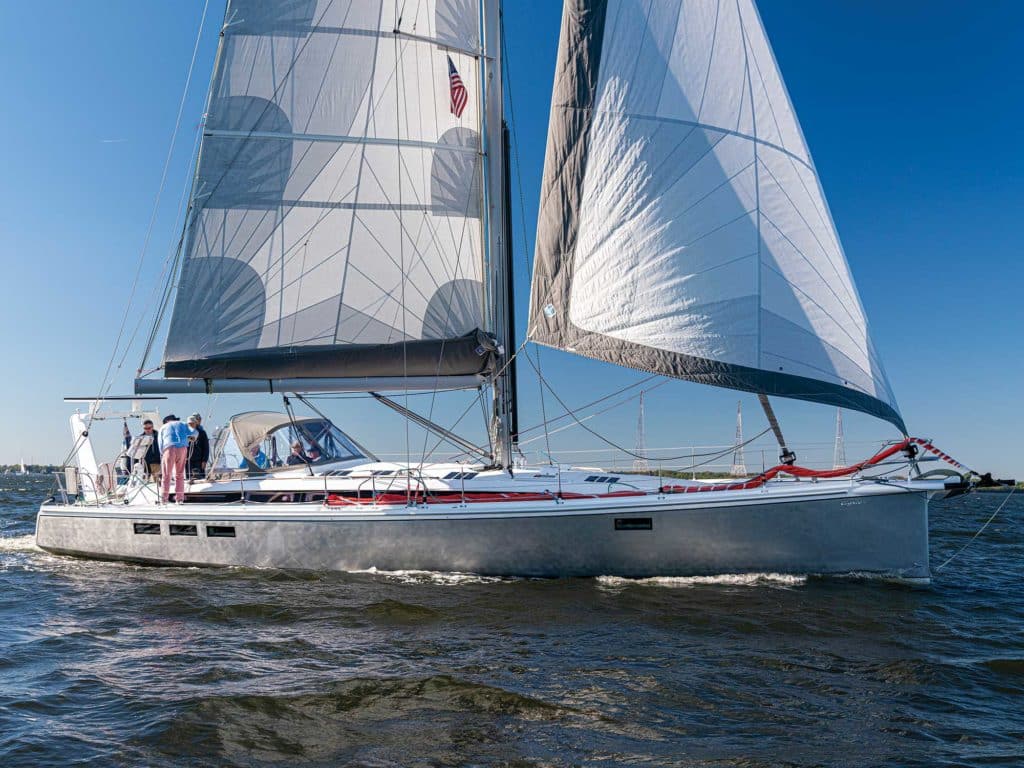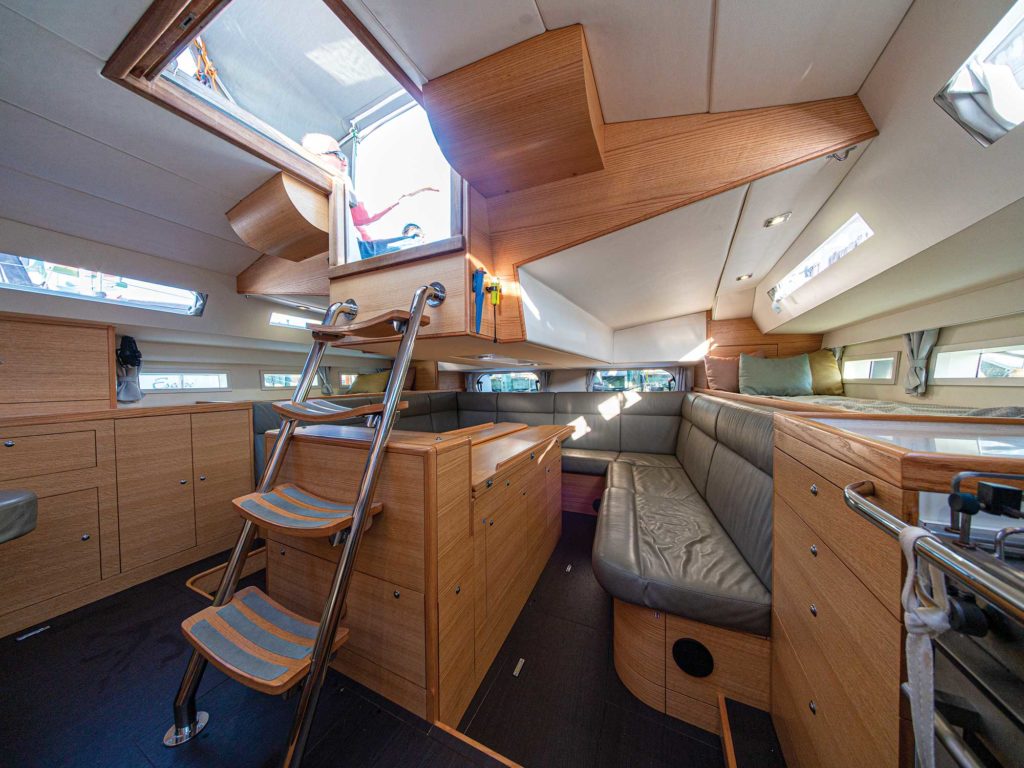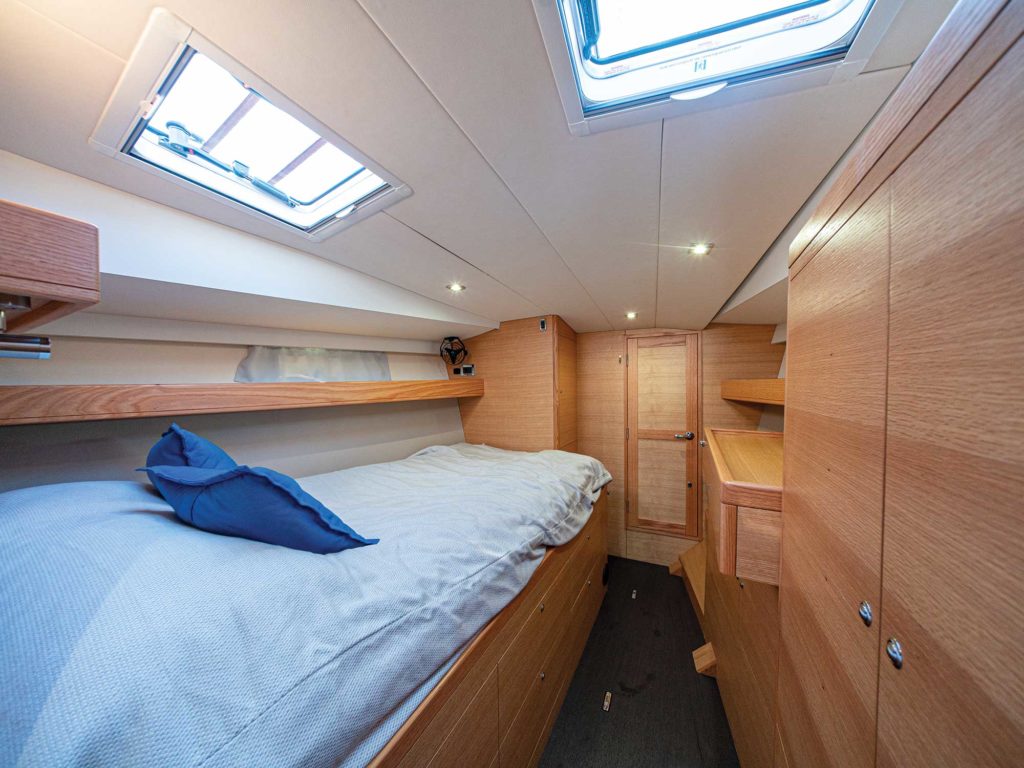
If sailors are individualists—and I firmly believe that we are—then there’s a subset of our community comprised of even stauncher iconoclasts, those who love and voyage upon metal boats. In this matter, having sailed some 28,000 nautical miles aboard a heavy steel vessel, including a transit of the Northwest Passage and a spin around Cape Horn, I consider myself part of that hearty tribe. That boat, called Ocean Watch, was a home-built, 64-foot Bruce Roberts design that I grew to love, but in a specific context: She was rough, rugged and built for service, not looks, and I came to view her as a workboat, not a “yacht” in the grand sense of the term. (Though I do find deep beauty in no-nonsense utility, particularly OW’s.)
Which brings us to the subject of the Cigale 16, from the French builders at Alubat, a popular, longtime leader in the category, now in its fifth decade. (Jimmy Cornell’s Alubat Ovni, Aventura, is one of the boatyard’s best-known examples.) Yes, the Cigale 16 is aluminum (alloy 5083) and shares the characteristics of her metallic sisterships (regular preventive maintenance is key). But she is also a smart and capable vessel with a high level of craftsmanship and really solid sailing performance. Unlike my fond Ocean Watch, the Cigale is a versatile, long-range yacht—in the best sense of the term.
Generally, when reviewing boats, I like to start with my take on the aesthetics, profile, and deck layout: you know, the topsides. But with the Cigale, such an approach would be, as they say, burying the lede. Because the thing that first knocked me out about the boat was not abovedecks but below, just down the companionway.
During our Boat of the Year inspections this past fall, we were fortunate to have the Cigale’s knowledgeable and experienced owner, Brit David Hobbs, to show us around. Clearly, one of his favorite features was the “aft saloon” directly beneath the cockpit, behind the companionway, home to a massive dining table (beneath which lives the extremely accessible Volvo auxiliary, with saildrive), settees and sea berths (the latter particularly sensational), and a full galley and navigation station flanked just forward of the living area, to either side (handy, no?). I’ve seen this approach before, many times; the ones I’ve been most smitten with were metal boats from French designers and/or builders. But it doesn’t get much better than what naval architect Marc Lombard has pulled off here. Hobbs gestured toward the bulkhead door leading forward, to the rest of the interior, and said, clearly pleased, “On passage, we don’t go up there.” Why would you? It’s bumpier and noisier. (That said, the accommodations and staterooms are first-rate and highly customizable.)

OK, I was kidding about the topsides, where the Cigale pretty much had me at hello as well. A few years back, the Cigale 16 underwent a redesign, with Lombard (well-known for his performance penchant) updating the original hull that was created by the Finot/Conq design team. (About 18 Cigale 16s were the earlier version; our test vessel was Hull No. 4 of Lombard’s take.) Hard chines, of course, are still part of the package, but the forward sections have been reworked to introduce better form stability. Coupled with the fact that nearly a third of the boat’s 12 tons of displacement sits in the lead ballast bulb at the business end of the welded aluminum keel (drawing more than 8 feet), I trusted Hobbs when he said, in understatement, “She’s pretty stiff.” (Unlike the Ovni range, which employs swing keels, all the Cigales built to date have fixed keels, though a swing keel is an option.)
Happily, I soon discovered the stiffness part for myself.
A few things about the Cigale, some of which might be attributed to her French accent: The deck-stepped aluminum spar (carbon’s an option) supports a huge square-topped main and utilizes a pair of running backstays—not your usual setup on a dedicated cruising boat. There are twin wheels and rudders (a single helm is an option) linked by cable steering; the cutter rig also has provisions for a code zero set off a retractable sprit.
Hobbs, whose planned South Pacific cruise has for now been waylaid by the pandemic, nonetheless has put some hard miles on the boat, including a trans-Atlantic shakedown where the boat notched a tidy 18 knots, as well as competing in Antigua Sailing Week. He’s a pretty passionate sailor and carries a full complement of off-wind reaching sails, which, on a puffy, up-and-down Chesapeake Bay sea trial, with winds that gusted into the high teens, I was more than happy to help him set and douse. And I was justly rewarded: With a big gennaker drawing, we knocked off beam-reaching speeds in the lower double-digits, with a helm that was both light and exacting. Just a fantastic sail.

With those running backs and a single line furling setup on the code zero—when that’s hoisted, there are three headsails from which to choose—it’s an athletic boat to run under sail. The efficient, double-ended German-style mainsheet works well; the running rigging is conveniently led below deck plates so that lines don’t get tangled underfoot; with flush deck hatches, the sloping foredeck is smooth and unencumbered. A rear arch is situated aft, just over the sugar-scoop transom, and is home to both a nifty davit arrangement and a perch for the solar panels and antennas. Interestingly, the owner of our test boat eschewed a generator, opting instead for the solar array and a Watt & Sea hydrogenerator to help top off the bank of AGM batteries, coupled with the Mastervolt inverter/charging system.
The Cigale 16 is clearly meant to go places, with comfort and swiftness to spare. You don’t even have to join the Metal Boat Society to participate. If far-distant voyaging is the goal, here’s a vessel that will take you there.
Herb McCormick is CW’s executive editor.








